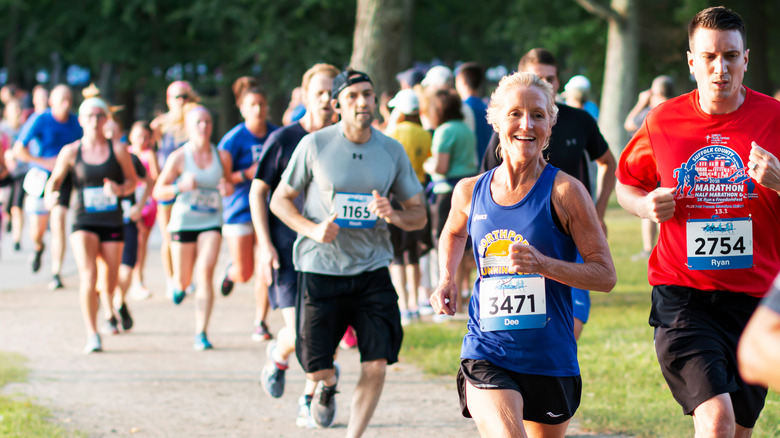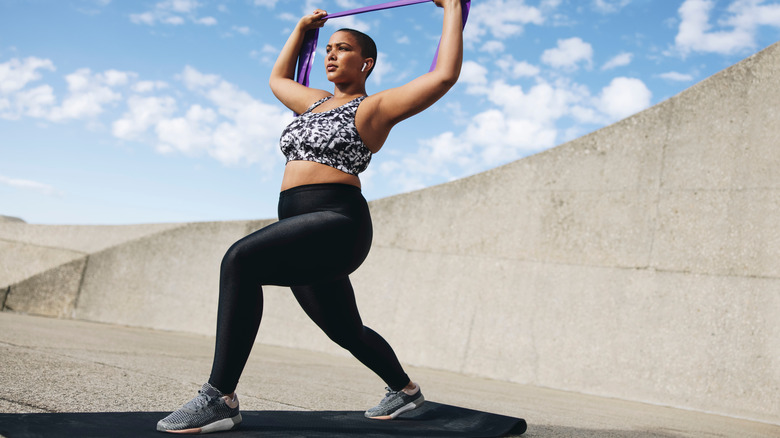Your Ultimate Guide To Preparing For Your First 5k Race
Brandi Barbre, a running coach in Missouri, told Fleet Feet that "the 5K is truly magical" because the training goals can easily be adapted to any runner. If you've been running for a little while and you're ready for a challenge, the 5K is great motivation to up your mileage or your pace. For experienced runners, the 5K is perfect for working on speed, per the experts at Runner's World. Even people who've never laced up (or bought) running shoes can take on the 5K, with the proper gear and training plan.
A 5K race covers a five-kilometer course, which adds up to 3.1 miles for those of us not used to the metric system. If you're brand new to running or still just a walker, that distance may sound daunting. But if you've got the time to dedicate to a training plan, you can be ready for one within a few months, even if you're starting with short walks around the block.
If 2023 is the year you're going to sign up for your first 5K, we've got you covered! Here's what you need to know before you pay the registration fee.
Gear you need to get started
Like any other hobby, there's lots of gear that could make your next run better as you start training for a 5K. But the great news is that there's really only one must-have piece of gear you need to start running — a great pair of shoes.
Marathoner and running coach Karen Janos told Active that running in any old sneakers can actually lead to injuries, especially for brand-new runners. So, it's important to get some new shoes that are specifically made for running. As Outside points out, running shoes are built differently than regular sneakers and made of different materials to optimize them for safe runs. So, even though a good pair of shoes can be expensive, splurging is a must. Luckily, they'll last you a long time, so think of it as an investment.
Once you've got the shoes, it's time to think about workout clothes. Though you can wear literally anything on a run, some good activewear will keep you more comfortable. Moisture-wicking materials work best. And if you've got a big chest, make sure to get a supportive sports bra.
Then there's the "nice to have" gear. A phone loaded with lots of workout music and a running app will help keep you motivated and track your run. Many apps even have 5K training programs loaded in. And if your pants don't have pockets (ugh), you might want an armband or running belt to hold your phone.
Going from walker to runner
If your fitness routine currently looks like casually strolling while you listen to a podcast, you might assume that a 5K isn't for you. But that's not true! With the proper training plan, you can be ready for the starting line in about 2-3 months.
The extremely popular Couch to 5K program lays out a training schedule that can get you 5K ready in nine weeks, and the Mayo Clinic can get you ready in just seven weeks. If you have the time, stretch your training out over a few months, to give your body more time to adjust.
No one expects you to go from walking to running for any extended period of time overnight. In fact, doing that is a recipe for injury. So, 5K training plans focus on building you up to running by combining walking and running in workouts a few times a week.
Some training plans are broken into walks/runs for a specific distance, while others specify the amount of time you should walk/run. Regardless, the workout is the same. Start walking, run for a bit, walk, and repeat! Some training plans let you pace yourself: walk, run until you're tired, then walk until you feel ready to run again. Others have set intervals for how long you should aim to run. Either way, the strategy is to build up the amount of running you do each workout until you're running all 3.1 miles.
Training if you're already a runner
Training for a 5K is a bit different if you're already running. Expert running coach Hal Higdon's tried and true Novice Program helps casual runners build up their mileage and endurance over eight weeks.
The program consists of walks/runs, short runs, and walks in a weekly plan. It starts small with just 1.5-mile run three times a week, walks/runs twice a week, one walking day, and one rest day. Higdon is a fan of the "run until you're tired, walk, then run again when you're recovered" model of walks/runs. Each week, the distance on the run days increases, until you're running 3.1 miles.
If you still consider yourself a beginner but you're looking for a more challenging training plan, you could try something like this training plan from REI Co-op. This plan is tailored toward people who can already run a few miles and focuses on building endurance and speed. Each run during the week focuses on a different kind of training: speed, endurance, and stamina. The other workouts include cross-training and active rest like yoga or stretching.
Either approach — slow and steady progress or athletic gains — will get you from casual runner to 5K. Which one you choose just depends on what your current running regimen looks like.
Slow and steady (training) wins the race
Running coach and endurance runner Calum Neff told Polar that one of the biggest mistakes that new runners make, especially when training for their first race, is amping up their training too quickly. He stressed that it takes time for the body to get used to any new activity, and running can be particularly stressful on the body. Because of this, it's important to gradually increase your running regimen. Neff recommends running at an easy pace to build up your muscles and endurance. Once you feel strong in easy runs, start picking up the pace or adding distance.
He added that upping your pace or your mileage too quickly can actually lead to injuries like shin splints, which will derail your training. The idea that training too hard too fast leads to injury is widely accepted in the running world, and research backs it up. A study published in the Journal of Orthopaedic & Sports Physical Therapy found that runners who increased the difficulty of their training by 30% over a two-week period were more likely to get injured.
So, when you're training for your first 5K, it's important to start slow and steady, and add a bit of distance and speed each workout. Following a training program specifically designed for 5Ks is a great way to ensure that you're safely amping up your training.
Finding your ideal 5K
Because 5Ks are among the most popular races, per World's Marathons, you should be able to find a race within driving distance most times of year. Active has a nationwide listing of races to choose from; simply plug in your location, find out what's happening in your area, and sign up!
While some people don't mind signing up for a random 5K, others choose their first race because of the theme, the race course, or the organization hosting the race. Many 5Ks have fun themes like Superhero 5Ks or Pirate 5Ks, and there are holiday-themed 5Ks, like the Santa Run.
Some themed races are classified as "fun runs," which are races that are more about the fun of the event than running. Events like the Color Run and the Zombie Run are favorites of less serious runners who want to have a good time. Many organizations, especially nonprofits and charities, will organize 5Ks to raise money for a good cause. If you want your first race to support an organization you feel passionately about, check out that organization's website to see if they have any races planned.
You can also choose your first race based on the race course. Many 5Ks are held in gorgeous locations, and you can make a vacation out of your first race (via Vacation Races). Choosing the best 5K for you depends on the experience you're looking for. Take your time to find the one that's right for you!
Getting and staying motivated
Staying motivated while you're training for a 5K is hard for many people. Luckily, there are lots of techniques for finding the motivation for each run and staying motivated throughout your training weeks. You just need to find the one that works for your brain!
Steve Carmichael, a personal trainer, running coach, and the founder of RunBuzz, suggests reframing your goals to find ongoing motivation. He points out that crossing the finish line of your first 5K isn't really your goal when you sign up for your first race; it's the sense of accomplishment you'll feel when you cross that finish line. On those days when you have zero desire to put on your shoes and hit the road, visualize the feeling you'll get when you finish your first 5K, and keep that feeling with you throughout your run. If that doesn't work, Carmichael suggests trying the opposite approach — visualize how lousy you'll feel about yourself if you skip your run and use that feeling to get out there.
Running with others is another great way to get that boost of motivation. You could enlist a close friend to sign up for the same 5K, or you could join a local running group. According to Run for Good, most local sports stores host running groups, so check there first. You can also check if national running groups like Road Runners Club of America and Running in the USA may have branches close to you.
Cross-training for a 5K
Obviously, running multiple times a week is the most important part of a 5K training plan. However, personal trainer Holly Martin writes in The Run Experience that cross-training — adding non-running workouts to your training program — is almost as important as each of your runs.
Cross-training can include a wide variety of different exercises like strength training by lighting weights, yoga, Pilates, swimming, rock climbing, or even your favorite sport. The idea behind cross-training is to use your muscles in a different way on the days you're not running. This gives the muscles you use the most while running a break and puts other muscle groups to work to build full-body strength and stability. Low-impact cross-training, like yoga or stretching, also gives your muscles time to rest, recover, and lengthen, which is just as essential as working them hard. In an article for BarBend, personal trainer Shane McLean pointed out that cross-training is also a crucial part of injury prevention.
The exercises included in a cross-training program will look different for each runner because we each have our own likes and dislikes as well as strengths, weaknesses, and needs. However, every good cross-training program should include full-body strength training as well as lower-impact exercises. A training schedule that includes cross-training may look like three runs, two strength training sessions, and one low-impact workout each week.
Rest days and active recovery days
A lot of us, especially those of us who love to work out, often forget that rest days and active rest days are just as important as workout days. Running coach Laura Norris always reminds her clients that running and cross-training are hard work on the body. Exercise actually creates micro-tears in the muscles, and we get stronger by letting these micro-tears heal. For that to happen, we need to rest. If we don't, our muscles become vulnerable to overtraining injuries. So, even though you might feel lazy taking a day off from training, you need to prioritize rest days!
Rest days don't always look like doing a Netflix marathon rather than the running kind though. Mia Kercher, a marathoner and writer for Marathon Handbook, points out that active recovery days are just as important as rest days. Active recovery gives your muscles the rest and healing time they need while still keeping your body moving. Going for a walk, doing some yoga, taking a Pilates class, or stretching and foam rolling are all great activities for active rest days.
To keep your body injury-free and at peak performance level, you'll need to include both active recovery and rest days in your training schedule. Depending on how often you're running and cross-training, one to two days of active recovery and one day of complete rest each week should keep your body healthy and happy.
Dialing in your nutrition
Running and cross-training require a lot of fuel for your body. To feel your best during your 5K training program, you'll need to focus on what and how you're eating. According to LuminisHealth.org, you don't have to make drastic changes to your diet while you're training for a race if you're already eating a variety of nutrient-dense foods. It's more about paying attention to the balance of carbohydrates, proteins, and fats you're eating and ensuring that you're eating enough to support your training regimen. A good tip is to load up half your plate with fruits and veggies at each meal, then split the rest of your plate between carbs and protein.
Shelby Eidel, a dietician who works at Johns Hopkins Medicine, stressed that even though carbohydrates get a bad rep, they're an essential part of a runner's diet. Carbs are the primary source of the energy your body needs to burn during a run. If you pass on the carbs, your runs will feel more difficult and sluggish.
Eidel also emphasized the importance of eating before a run, but not right before a run. Having a meal with a good balance of carbs, fats, and protein a few hours before your run is ideal. But if the timing doesn't work out, a carbohydrate-rich snack about 30 minutes before your run works too, as long as it's easily digestible. Grabbing a protein-rich snack after your run is important too as it helps with muscle recovery.
Hydrate, hydrate, hydrate
Staying hydrated both during your workouts and throughout the day is another essential aspect of keeping your body safe and performing at its best. According to Brigham Health Hub, water performs several jobs in the body including protecting the joints, eliminating waste, powering the cells, and regulating our body temperatures, and all these processes need to be operating smoothly for a good workout.
When you're not well-hydrated during a workout, you're more likely to injure yourself, or at the very least get some nasty exercise cramps. This is because we're literally 20 times hotter while exercising than we are at rest. That's why we sweat so much. And when we sweat, we lose water, electrolytes, and vital vitamins. All of those need to be replaced by rehydration during and after every workout.
Staying hydrated throughout the day is just as important because it essentially gives us a well to pull from during workouts. REI Co-op suggests drinking 17-20 ounces of water over a few hours before your workout, 5-10 ounces every 15 minutes during your workout, and 16-24 ounces of water after each workout. In general, you should be drinking about 64 ounces of water each day to ensure you're hydrated enough to support your training schedule.
Sleeping for better training
Anyone who's tried to go for a run after not getting a good night's sleep knows how awful it can feel. According to Runkeeper, the reason it feels awful is because your body hasn't had the chance to recover from the previous day and all the work it did. Some of the hormones essential for muscle recovery only get released when we're asleep. When you don't get enough sleep, your body literally can't repair itself the way it needs to. Additionally, your heart rate and blood circulation adjust while you're asleep to optimize your cardiovascular health, so when you skimp on sleep, you're actually limiting cardiovascular performance.
We all know that being tired has mental impacts as well as physical impacts, and Outside confirms that a lack of sleep absolutely changes your perspective on working out. Multiple studies have found that people who didn't get enough sleep the night before view their workouts as harder than they did on days when they did get enough sleep.
While you're training for a 5K (and when you're not), prioritizing sleep is vital to your health, physical performance, and mental and emotional well-being. So, aim for seven hours each night at the very least, and more like eight to ten hours a night if you want to feel your best.
Preventing injuries
Injuries including shin splints, stress fractures, plantar fasciitis, and runner's knee are common among new runners. There are a few reasons why this happens, according to MedStar Health. One is increasing your activity duration and intensity too quickly. If you suddenly go from not running regularly to running multiple times a week, your body doesn't have time to adjust to the strain of the new activity.
Another common reason for running injuries is not giving the body enough time to rest between runs. When the muscles, tendons, ligaments, and bones don't have enough time to repair themselves between runs, the strain adds up to actual damage, causing an injury. A lack of strength and flexibility can also be behind running injuries, especially if you're not taking the time to cross-train.
The Cleveland Clinic points out that footwear is also a common culprit. When the shoes you're running in aren't supportive enough, the impact of running puts too much strain on the feet and legs, leading to injury. The best ways to prevent running injuries are to get fitted for proper running shoes at your local sportswear store, gradually increase your training over time, strength train and stretch to ensure you have enough strength and flexibility, and take regular rest days and active recovery days.
Race week prep
When the week before your first 5K finally rolls around, it's important to use that time to properly prepare so you can have your best possible run on race day. One of the most important parts of race week prep is tapering your training. Rutgers Recreation suggests starting to gradually decrease the distance and time that you're running at least a week before race day, or even a few days before that. They suggest cutting your training by 30-50% so your body gets extra rest and recovery time before the race.
The popular running blog Runnin' For Sweets, which is written by a frequent marathoner, suggests swapping one of your cross-training days for a rest day as well. Balancing extra rest and light training the week before your race ensures that your body is in peak condition on race day.
Your race week diet is also essential for race day success. Make sure to hydrate as much as possible so that you're not going into race day slightly dehydrated. Race week is definitely not the time to try new foods because digestive upset can lead to dehydration or cause uncomfortable bloating that will derail your race week workout schedule. Carb loading isn't necessary for a 5K because it's a relatively short distance. So, focus on well-balanced, nutrient-dense meals throughout the week.
Last but certainly not least, take the time to plan the logistics of race day.
Race day!
Knowing what to expect on race day will increase your chances for a good run and calm your nerves, though some nervousness on race day is normal and unavoidable. Matt Fitzgerald, an accomplished racer and running coach, told Active that he recommends starting race day with a light, easy-to-digest meal. Though it seems counterintuitive, experts agree you should moderate hydration on race morning. Too much water can cause bloating and leave you searching for a port-a-potty during the race. This is why it's so important to hydrate well during race week.
Running coach Caroline Geoghegan suggests reviewing the logistics one more time as well. Make sure that you have your race packet all ready to go or know where you need to pick it up on race day. Double-check your route to the race, where you can park, and where you can leave your valuables. And make sure to put everything you need — water, your phone, wallet, headphones, etc. — is in your running pack.
Before the race, it's crucial to do a light warmup. Some races organize a group warmup before the race, so feel free to join that. If not, you can warm up on your own before your start time. This could look like some stretching, some yoga, or a light jog around the starting area.
And most importantly — have fun! All your hard work got you here, now it's time to just enjoy the run.














